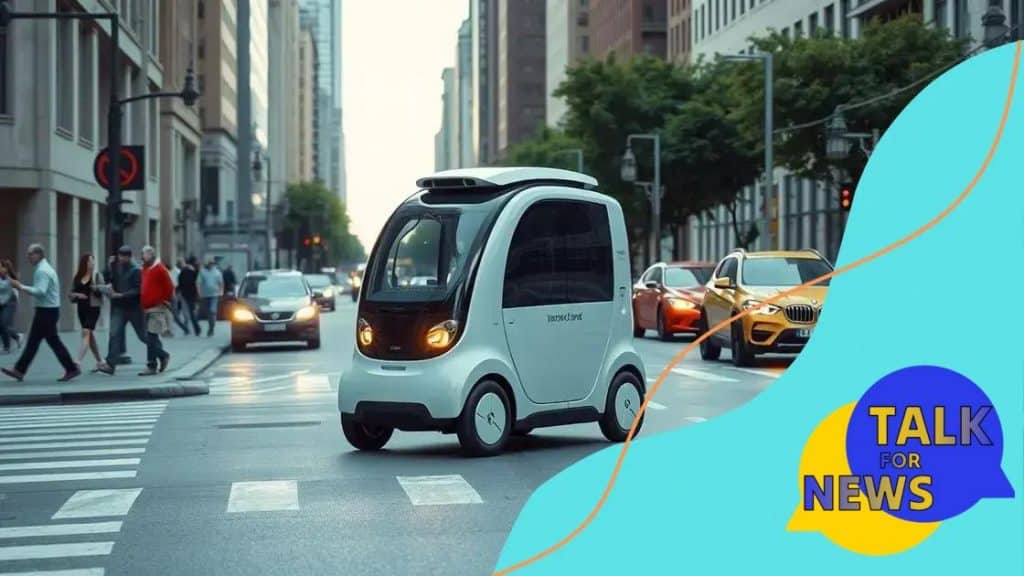How autonomous vehicles will change the future of logistics

Anúncios
Autonomous vehicles will transform logistics by enhancing efficiency, reducing costs, and improving delivery accuracy, supported by advanced technologies like AI and IoT.
How autonomous vehicles will change the future of logistics is a topic bringing excitement and concern alike. As we stand on the brink of this new era, have you considered how these innovations might affect our everyday delivery systems?
Anúncios
The technology behind autonomous vehicles
The technology behind autonomous vehicles is fascinating and complex, combining various fields of innovation. These vehicles utilize advanced software, sensors, and artificial intelligence to navigate and operate without human intervention.
Key Components of Autonomous Technology
A few crucial technologies play a role in making these vehicles autonomous. Here are the main components:
- LiDAR: This sensor uses light to create detailed maps of the vehicle’s surroundings, providing a 360-degree view.
- Computer Vision: Aiding in image processing, this technology helps the vehicle interpret visual data from its environment.
- Machine Learning: Algorithms that enable vehicles to learn from data and improve their performance over time.
- GPS and Mapping: Accurate positioning systems are vital for navigation and route optimization.
Anúncios
Each component works in harmony to ensure that the vehicle can make informed decisions, from detecting obstacles to following traffic rules. One of the most critical aspects of this technology is the communication between different systems. Vehicles often share data with each other and with infrastructure, enhancing safety and efficiency.
The Role of Artificial Intelligence
Artificial intelligence plays a pivotal role in processing all the data collected from various sensors and making real-time decisions. The integration of AI algorithms allows vehicles to predict potential hazards and respond appropriately. This capability is fundamental for ensuring the safety of both passengers and pedestrians.
Moreover, the more data these vehicles process, the smarter they become. Continuous learning is essential for improving their navigation systems and safety protocols. The technology is not just about driving; it’s about creating a network of vehicles that can communicate and collaborate for better traffic management.
As autonomous vehicle technology continues to develop, it will likely lead to revolutionary changes in logistics and transportation. Imagine roads filled with vehicles that can automatically adapt to changing conditions, reducing accidents and improving efficiency.
Impact on supply chain management
The impact on supply chain management from autonomous vehicles is significant. These vehicles promise to streamline processes, reduce costs, and enhance overall efficiency in logistics.
Efficiency Enhancements
One major benefit is the improvement in delivery times. Autonomous vehicles can operate without breaks and navigate more effectively, allowing for quicker shipments. This means products reach customers faster, improving satisfaction.
- Reduced Human Error: Automation decreases the likelihood of mistakes made during deliveries.
- Increased Reliability: Autonomous vehicles can follow precise schedules, ensuring timely arrivals.
- Cost Savings: Less reliance on human drivers cuts down on labor costs.
- 24/7 Operations: These vehicles can make deliveries any time of day or night.
The flexibility of autonomous vehicles allows companies to adapt quickly to changing demands. With real-time data analysis, logistics managers can reroute vehicles based on traffic conditions or delivery priorities. This level of adaptability improves supply chain resilience, especially during peak seasons or unforeseen events.
Impact on Inventory Management
Furthermore, autonomous vehicles can have a positive impact on inventory management. Using accurate tracking systems, companies can minimize stockouts and overstock situations, keeping costs in line. When deliveries are consistent and reliable, businesses can more effectively manage their inventory levels.
This efficient management leads to better resource allocation and reduced waste. With enhanced predictability in deliveries, companies can optimize storage space, leading to a leaner supply chain model.
In summary, the introduction of autonomous vehicles offers transformative potential for supply chain management by boosting efficiency, reliability, and flexibility. As this technology evolves, its impact will only grow, reshaping how goods are transported.
Benefits of automation in logistics

The benefits of automation in logistics are many and impactful, changing how businesses operate. By integrating automation, companies can streamline operations and enhance productivity.
Cost Reduction
One of the primary advantages is significant cost savings. Automation reduces the need for manual labor, leading to lower labor costs and fewer errors. With fewer mistakes, companies can avoid the costs associated with returns and delays. Automating routine tasks allows staff to focus on higher-value activities, improving overall efficiency and effectiveness.
- Faster Processing Times: Automation speeds up sorting and delivery processes.
- Improved Inventory Accuracy: Automated systems track inventory levels more effectively.
- Enhanced Data Management: Real-time data is available for better decision-making.
- Scalability: Businesses can easily scale up operations without significant investments.
When logistics functions are automated, it not only increases speed but also enhances the reliability of deliveries. Automation minimizes human error, leading to more accurate order fulfillment. This reliability fosters better customer relationships because clients receive their products on time and as expected.
Increased Efficiency
Automation also leads to greater efficiency across supply chain processes. With automated systems, tasks that once took considerable time can be completed quickly. For instance, automated vehicles can transport goods without delays, even in complex supply chains.
Moreover, the use of technology enables more precise routing and scheduling. By analyzing traffic patterns and warehouse locations, automated systems can optimize routes, reducing travel time and fuel consumption. This efficiency results in improved service levels without increasing operational costs.
In a competitive marketplace, the shift towards automation helps companies maintain a lead over competitors. As logistics continue to evolve, embracing automation will be vital for success.
Challenges and solutions for implementation
Implementing autonomous vehicles in logistics presents several challenges. These hurdles can affect how quickly and efficiently companies can adopt this transformative technology.
Regulatory Hurdles
One major challenge is navigating the regulatory landscape. Various laws and safety standards govern the use of autonomous vehicles. Companies must ensure they comply with these regulations, which can vary widely by location.
- Safety Standards: Meeting strict safety criteria is essential to gaining public trust.
- Insurance Requirements: Adjusting insurance policies to cover autonomous operations can be complicated.
- Licensing and Permits: Securing the necessary licenses and permits can be time-consuming and costly.
Addressing these regulatory concerns requires collaboration with policymakers. Engaging in dialogue can help shape favorable regulations that support innovation while ensuring public safety.
Technological Integration
Another challenge lies in the integration of new technologies with existing systems. Many logistics companies rely on established processes that may not easily accommodate autonomous vehicles. It is crucial to smoothly integrate these technologies for efficiency.
Logistics businesses might face issues such as:
- Legacy Systems Compatibility: Ensuring new software and hardware work seamlessly with older technology.
- Data Management: Handling vast amounts of data from autonomous operations can be complex, requiring advanced analytics tools.
- Training Staff: Employees must be trained to work alongside autonomous systems effectively.
To solve these challenges, companies should invest in training programs and technology that supports a smooth transition. Investing in robust data management systems can help make sense of the information flow.
Ultimately, while the road to implementing autonomous vehicles in logistics may be complex, addressing these challenges head-on can pave the way for a more efficient and automated future.
Future trends in autonomous logistics
The future trends in autonomous logistics promise to reshape the way we think about transportation and supply chain management. As technology continues to evolve, logistics will become more efficient, responsive, and integrated with other systems.
Increased Adoption of AI
One key trend is the increased use of artificial intelligence (AI) in logistics operations. AI can analyze vast amounts of data to optimize routes and predict demand. This will lead to smarter decision-making, reducing costs and improving service levels.
- Predictive Analytics: Using data to forecast demand and adjust operations accordingly.
- Smart Routing: AI can calculate the best paths for delivery trucks in real-time, considering traffic and weather conditions.
- Autonomous Warehouses: AI will manage inventory and coordinate robotic systems for efficient order fulfillment.
The overall effect of AI is a more agile supply chain that can respond quickly to changes in demand and unforeseen circumstances. This adaptability is crucial in today’s fast-paced market.
Integration with Internet of Things (IoT)
Another important trend is the integration of autonomous vehicles with the Internet of Things (IoT). IoT devices can provide real-time tracking of vehicles and shipments, improving visibility throughout the supply chain.
With connected sensors, businesses can monitor the location and condition of their products at all times. This enables timely interventions if issues arise, such as delays or damages. The benefits include:
- Enhanced Visibility: Companies can track shipments in real-time, providing updates to customers.
- Efficient Resource Management: Data from IoT can help optimize resource allocation across the supply chain.
- Reduced Downtime: Predictive maintenance alerts can prevent vehicle breakdowns, ensuring smoother operations.
As the interplay between autonomous logistics and IoT strengthens, businesses will find innovative ways to improve their services and cut costs.
In summary, as we look into the future, trends like AI adoption and IoT integration will significantly influence autonomous logistics, creating opportunities for growth and efficiency.
FAQ – Frequently Asked Questions about Autonomous Vehicles in Logistics
What are the main benefits of using autonomous vehicles in logistics?
Autonomous vehicles can significantly improve efficiency, reduce costs, and enhance delivery speed, leading to better customer satisfaction.
How does AI contribute to autonomous vehicle operation?
AI helps autonomous vehicles make real-time decisions based on data from sensors and external conditions, optimizing routes and safety.
What challenges do companies face when implementing autonomous logistics?
Companies may encounter regulatory hurdles, the need for technological integration, and the necessity of training staff to work with new systems.
How can IoT enhance the functionality of autonomous logistics?
IoT devices provide real-time tracking and data analysis, improving visibility and resource management throughout the supply chain.





